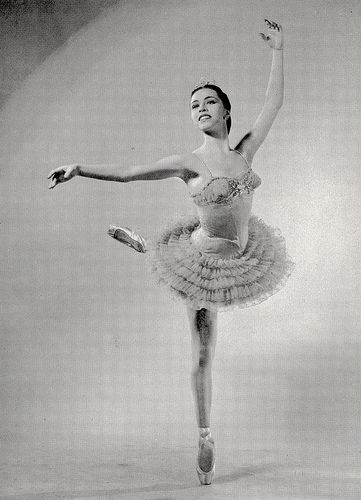Spotlight: Maria Tallchief
- Selene
- Sep 24, 2016
- 7 min read
Today's Spotlight Saturday focuses on famous Native American ballerina Maria Tallchief.

On the cover of 'Dance Magazine', 1954
She was born Elizabeth Marie Tall Chief in Fairfax, Oklahoma, on 24 January 1925, to parents Alexander Joseph Tall Chief and his wife Ruth. Tall Chief, known by the nickname 'Betty Marie', had five siblings, including her sister Majorie, a ballerina in her own right.
Her great-grandfather had helped negotiate the deal that gave the Osages rights over oil revenues, and as a result her father had 'never worked a day in his life'. The family were reasonably wealthy and owned several major buildings in the town, giving the young Maria the impression that her father 'owned the town'. Not everything was rosy, however; her father was an alcoholic and her parents often argued about money.

In costume for 'Scotch Symphony'
Maria's mother Ruth, who had never been able to afford dance lessons as a child, enrolled her daughter in summer ballet classes at the age of 3. Maria and other family members were soon performing at local events, and Maria also began studying piano, later contemplating a career with it. In 1930, ballet teacher Mrs. Sabin took on Maria and her little sister Marjorie as students. Maria later remembered her as a 'wretched instructor who never taught the basics, and it's a miracle I wasn't permanently harmed.' In addition to her questionable teaching methods, Mrs. Sabin put Maria on pointe at the age of 5, far too young to be dancing on her toes without running a major risk of severe damage. Maria was also a gifted student at school, and between school work, ballet and piano had very little spare time, most of which she spent outdoors.
In 1933, the family moved to Los Angeles with the hope of getting the children into musicals. Looking for a new dance teacher, they were recommended Ernest Belcher, the father of American dancer Marge Champion. Belcher immediately took Maria off pointe, saving her feet, and Maria soon discovered that she had in fact been learning ballet all wrong; she had to start back at square one, but was soon devoted to her dance classes. In addition to ballet, she learnt tap, Spanish dance, and acrobatics at the dance school.

In costume for 'Swan Lake'
The family moved to Beverly Hills, which offered better schools. It was at this point that, suffering from discrimination, Maria joint her last name into a single word. She continued her piano studies, appearing as a guest pianist with small orchestras throughout her time at high school. At the age of 12, she was taken on by Bronislava Nijinska, the great choreographer, and David Lichine, a former dancer and choreographer. It was under Nijinska's direction that Maria decided she wanted to become a professional ballerina, instead of a concert pianist. Nijinska, who could tell that the young dancer was serious about her goal, devoted great attention to her.
When Maria was 15, Nijinska staged three ballets in the Hollywood Bowl. Though initially she was put in the corps de ballet, with her sister Majorie and Cyd Charisse, later a Hollywood starlet, she worked hard for the lead role in Chopin Concerto. She received instruction from various famous teachers whilst they were on visits to Los Angeles, including Ada Broadbent, for whom she danced her first pas de deux. Russian dancer Mia Slavenska took a liking to her and arranged for her to audition for Serge Denham, the director of the Ballet Russe de Monte Carlo, but nothing came of it.

When Maria graduated from high school in 1942, she wanted to go to college, but her father refused to pay for it and instead she sought work. She had a bit part in a Hollywood musical starring Judy Garland, Presenting Lily Mars, but didn't enjoy the work. Instead, she went to New York under the chaperonage of Tatiana Riabouchinska, a family friend and one of the Ballet Russe's three 'Baby Ballerinas'. Maria was just 17, but that was considered old for the Ballet Russe de Monte Carlo, who had employed ballerinas as young as 13.
On first approaching Serge Denham, Maria was at first told there were no positions available. She went home in tears, but a few days later she was told she had a place with the company after all. Maria had two things on her side: talent, and a passport. During the war years, people without passports were barred from entering many countries, including Canada, where the company had an upcoming tour. Many of the ballet's dancers were Russian refugees and had no passports. Maria first performed with the company in Gaite Parisienne.

Soon she was offered a permanent place, which she accepted. On her first day as a full member of the company, she learnt that Nijinska had come to stage a production of her Chopin Concerto. She cast Maria as the understudy to ballerina Nathalie Krassovska. Her sudden elevation by Nijinska caused resentment from the Russian dancers, who considered American dancers inferior. Choreographer Agnes de Mille suggested that she change her name. Dunham had already suggested that she follow the established practice of changing her name to its Russian counterpart, Tallchieva, but she had refused. de Mille suggested changing her first name instead. It was at this point that she became Maria instead of Betty Marie.
She took classes at the American School of Ballet when she could, but on tour she had to make do with rehearsals and studying her more experienced colleagues. She particularly admired Alexandra Danilova. Nathalie Krassovska was frequently in arguments with management, and when she left in 1943, Maria was told she would replace her. She did not feel at all ready to perform Krassovska's technically difficult role. However, she received good reviews in New York. But she soon returned to the corps de ballet after Chopin Concerto.

In costume for 'Swan Lake'
She got a minor role in The Snow Maiden, but her mother attempted to talk her into quitting the company when she saw how frail and stressed Maria was. But Maria refused to quit, and was rewarded the next year, when she received a role in Le Beau Danube and a lead in another Nijinska ballet, Ancient Russia. It was then that George Balanchine entered her life. The Ballet Russe de Monte Carlo were preparing to perform The Song of Norway on Broadway, and he was their new choreographer and ballet master. He took an immediate liking to Maria, giving her a solo and informing her that she would be understudying Danilova for the lead role.
She went on to perform in a jazzy trio Danses Concertantes, Le Bourgeois Gentilhomme, and was given second lead in Ballet Imperial. On August 16, after a sudden proposal, Balanchine and Maria were married. Maria worked with Balanchine to correct her technique, and relearnt a great deal of the basics of ballet in order to capture Balanchine's ideal. She was also mentored by Danilova, and the combined efforts of both turned her into a rising star. She was made a featured soloist, creating the role of Coquette in Night Shadow.

Maria with George Balanchine
In 1946, Balanchine left to form the Ballet Society, the forerunner to the New York City Ballet. Maria's contract with the Ballet Russe de Monte Carlo didn't run out for another six months, and so she didn't join Balanchine until 1947; he was in France as a guest choreographer for the Paris Opera Ballet, but was not exactly welcome. Despite personal attacks in the newspapers, he stayed on. Maria was given roles in Le baiser de la fee and Apollo. French audiences were fascinated by her; she was the first American to dance at the Paris Opera.

In costume during her time at the Paris Opera Ballet
Maria and Balanchine returned to New York, where she quickly became the new star of the New York City Ballet, which opened in October 1948. She became Balanchine's muse, and he created many roles for her. The most famous of these was 'The Firebird', which she first performed in 1949. She became as deeply associated with the role as Pavlova had been with the Dying Swan.

In costume for 'Firebird'
She became America's first proper prima ballerina. In 1954, Balanchine reworked the then rather obscure ballet The Nutcracker and gave her the starring role of the Sugar Plum Fairy. It became an instant Christmas classic. She also starred as the Snow Queen in Balanchine's Swan Lake and as Eurydice in Orpheus. She then had leads in Prodigal Son, Jones Beach, A La Francaix, Sylvia Pas de Deux, Allegro Brilliante, Pas de Dix, and Symphony in C.

In costume as the Sugar Plum Fairy with Nicholas Magallanes as the Cavalier, 'The Nutcracker', 1954
Maria remained at the New York City Ballet until 1960, but also guest-starred with other companies including the Chicago Opera Ballet, the San Francisco Ballet, the Royal Danish Ballet, and the Hamburg Ballet. She returned to the Ballet Russe de Monte Carlo between 1954 and 1955, for $2000 a week, the highest salary ever paid to a dancer at the time. In 1958, she danced the lead in Balanchine's Gounod Symphony before going on leave to have her daughter.
Returning to dance, she joined the American Ballet Theatre, first as a guest and then as a principal dance. During this period she became the first American to dance at the famous Bolshoi Theatre. Maria also appeared on television, portraying Anna Pavlova in the 1952 film Million Dollar Mermaid, and was Rudolf Nureyev's partner on his American debut in 1962. She then danced with the Hamburg Ballet on the urging of Balanchine, but retired for a few brief months. Among her last performances was Cinderella in 1966.

With Erik Bruhn in 1961, costumed for 'Swan Lake' at the Bolshoi
After retirement, she moved to Chicago with her husband Buzz Paschen (she and Balanchine had annulled their marriage in 1952). She was director of baller for the Lyric Opera of Chicago from 1973 to 1979. In 1974, she founded the Lyric Opera's ballet school, teaching Balanchine's techniques. She founded the Chicago City Ballet in 1981 with her sister Marjorie, serving as co-artistic director until the company failed in 1987. She was then an artistic advisor to the Chicago Festival Ballet from 1990 until her death.

'Swan Lake'
Maria broke her hip in December 2012. She died on 11 April, 2013, from complications caused by this injury. Maria was the first Native American to hold the title of Prima Ballerina. She became the foremost ballerina in America, praised for her energy, passion and technical ability. She helped to establish American ballet in its own right, setting its tone as bold and adventurous. Ashley Wheater, director of the Joffrey Ballet, called her 'not just a great dancer, but a real artist.'
Here's an interview with Maria including several clips of her dancing in Firebird:

'Firebird'
Thanks for reading! Next week the Spotlight will be on Isadora Duncan.
- Selene
































Comments